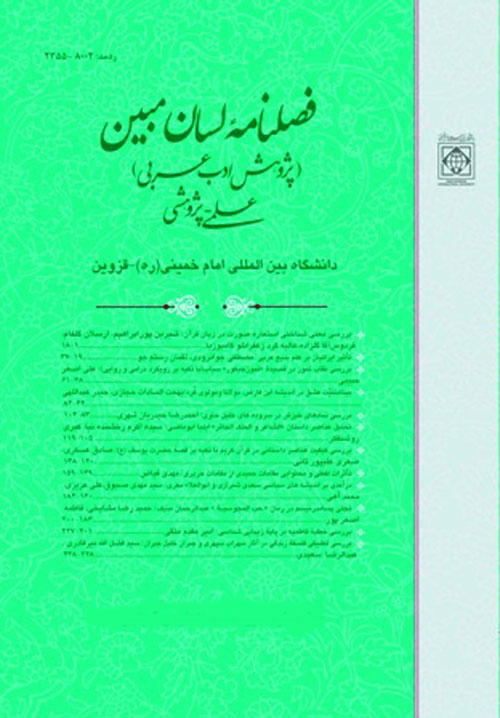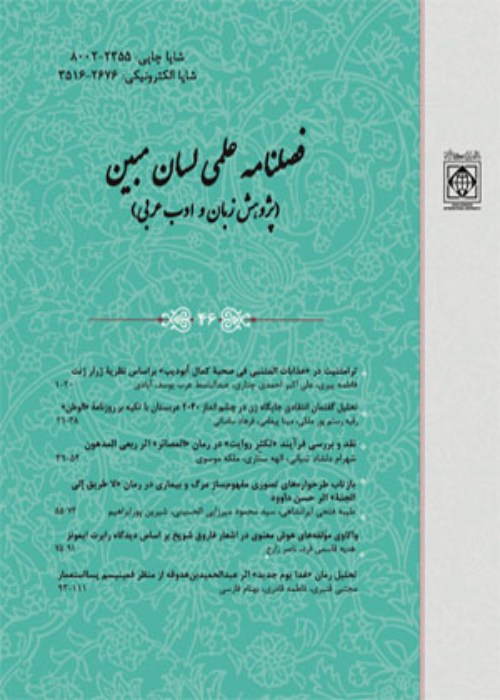فهرست مطالب

فصلنامه لسان مبین (پژوهش ادب عرب)
پیاپی 29 (پاییز 1396)
- تاریخ انتشار: 1396/09/30
- تعداد عناوین: 7
-
- مقاله پژوهشی
-
صفحات 1-22مقاله حاضر با روش توصیفی تحلیلی و بر مبنای زبانشناسی مقابله ای و نظریه تحلیل خطا، به بررسی و تحلیل خطاهای حروف جر در نوشتار دانشجویان زبان عربی در ایران پرداخته است. پس از تقسیم بندی خطاها بر اساس منشا بروز، معلوم شد که شایع ترین خطاهای زبان آموزان به ترتیب مربوط به تداخل بینازبانی، درون زبانی و تداخل هردو زبان یا مبهم، و از میان خطاهای بینازبانی بیشترین خطاها مربوطه به بکارگیری حرف «باء» به جای دیگر حروف جر(إلی، علی و فی) است. این امر نشان می دهد که حرف باء به خاطر تشابه ظاهری آن در دو زبان عربی و فارسی، زبان آموز را به اشتباه انداخته است. همچنین در خطاهای درون زبانی بیشترین خطاها مربوط به استفاده از حروف جر دیگر-بویژه إلی، علی و من- به جای حرف «لام» بوده است، نشان می دهد که زبان آموز به دلیل تشخیص ناقص در کاربرد حروف مخصوص زبان عربی، دچار این اشتباه شده است.
فزونی خطاهای بینازبانی بیانگر آنست که دانشجویان زبان عربی در بکارگیری حروف جر تا حد زیادی تحت تاثیر زبان فارسی هستند. از دلایل این امر آنکه؛ در واقع آنها فارسی می اندیشند و عربی می نویسند و دلیل دیگر این که آموزش زبان عربی در ایران بر خلاف زبان انگیسی در سنین پایین چندان مورد توجه قرار نمی گیرد که (طبق نظر زبانشناسان) این امر احتمال تداخل بینازبانی را در سنین بالاتر بیشتر می کند. دلیل دیگر آن است که فارسی و عربی در دو خوشه زبانی متفاوت هستند. زبان عربی در خوشه سامی جای دارد، برخلاف فارسی و انگلیسی که هردو متعلق خوشه هند و اروپایی هستند.کلیدواژگان: تحلیل خطا، حروف جر، زبانشناسی مقابله ای، تداخل، زبان عربی -
صفحات 81-104
-
صفحات 129-146تحلیل فراگفتمان نوعی تحلیل زبانشناسی است که خواننده را به فراسوی متن می کشاند و بین خواننده و نویسنده ارتباطی مشارکت آمیز ایجاد می کند. در همین زمینه کن هایلند با ارائه الگوی نظری فراگفتمان، دامنه وسیعی را در شناخت بهتر ارتباط مشارکتی بین نوع نگرش خواننده و نویسنده متن بیان کرده است. در چارچوب نظری وی، نویسنده از ابزارهای مختلف فراگفتمانی نظیر نگرش نماهای مثبت و منفی (صفاتی نظیر شیوا و ضعیف)، تردیدنماها (کلماتی مانند شاید) و یقین نماها (قیدهایی مانند حتما) برای بیان ارزش های یک پدیده، میزان تردید و قطعیت در خصوص یک گذاره استفاده کرده است. بررسی کتاب های نقدی براساس این الگو، معیاری برای تبیین شیوه نگرش ناقدان است. پژوهش حاضر در صدد است با روش توصیفی-تحلیلی و بر مبنای الگوی فراگفتمانی هایلند به بررسی مقوله های زبانی- بلاغی کتاب «فی الادب العباسی، الرویه والفن» اثر عزالدین اسماعیل بپردازد. یافته های پژوهش حاکی از درصد بالای مقوله های زبانی در کتاب به ترتیب زیر دارد ؛ استنادها 451 و گذاره ها 335، ابهام زداها 324، خوداظهاره جمع 269 و راهنمایی خواننده در متن 246 مورد. این ارزیابی زبانی بر این امر دلالت دارد که نویسنده متن را به مثابه کنشی اجتماعی می داند و سعی در مشارکت دادن خواننده را دارد.کلیدواژگان: نقد، فراگفتمان، هایلند، عزالدین اسماعیل
-
صفحات 147-173این پژوهش از دیدگاه زبان شناختی به این مساله می پردازد که ترجمه ی شعر چگونه ماهیت زبانی شعر عربی و مولفه های سازنده ی آن را به زبان فارسی منتقل می کند؟ روش پژوهش تحلیلی- تطبیقی است. در بخش تحلیلی، ابتدا برمبنای نظریه ی فرمالیسم ماهیت شعر و چهار مولفه ی سازنده ی آن (هنرسازه ها، نظام، ریتم، و درون مایه) تبیین می شوند. سپس با مطالعه ی نمونه هایی از ترجمه ی شعر از عربی به فارسی، چارچوبی زبان شناختی برای تحلیل این کنش طرح می شود. این تحلیل نشان می دهد ترجمه برای حفظ ماهیت شعر عربی در زبان فارسی، نقش شعری زبان را در زبان فارسی فعال می کند تا اثری تولید کند که از نظر نحوه ی کاربست عناصر زبانی با اثر اصلی معادل باشد. این تعادل از طریق بازآفرینی چهار مولفه ی سازنده ی فرم شعر عربی در قالب فرم شعر فارسی حاصل می شود. در بخش تطبیقی، مطالعه ی نمونه هایی از قصیده ی لامیه العجم همراه با ترجمه ی فارسی آن، چگونگی این بازآفرینی را عملا نشان می دهد.کلیدواژگان: ترجمه پذیری شعر، ترجمه شعر عربی، فرمالیسم، بازآفرینی فرم شعری
-
Pages 1-22Considering the importance of teaching Arabic language in Iran, this paper aims to describe and analyze the prepositions errors committed by native Persian-speaking students.
After the classification of the errors, based on occurrence origin, most errors were related to interlingua, then intralingual, and ambiguous ones.
Then the most of interlingua errorss are occurred in letter" ba" so that The ba has used instead on the "ela" ,"ala" , and "fee" because of its similarities in both Arabic and Persian. Also, in the intralingual errors, the most common mistakes related to the use of other letters-especially "ila", "Ala" and "Men" instead of the "Lam". this indicate that the learner was mistaken for the inadequacy of the use of the Arabic of prepositions.
al errors indicates that Iranian students of Arabic have been greatly influenced by the Persian language. In fact, they think in Persian, and then write in Arabic. One of the reasons is that Arabic learning, unlike English learning, is not much considered in the early ages, and according to linguists, the later the learning of a language, the greater the probability of interlingual errors . Another reason is that Arabic and Persian language are in two different language clusters .The Persian belongs to the Indo-European cluster and Arabic to Semitic cluster.Keywords: error analysis, prepositions, contrastive linguistics, interference, Arabic language -
Pages 129-146Metadiscourse analysis is a kind of linguistic analysis that drags reader to beyond text and provides cooperative communication between reader and writer. In this field, Ken Hyland with providing of metadiscourse theory pattern has expressed a wide range to better understand for participatory communication between attitude of reader and author of the text. In this theoretical framework, writer has been used from metadiscourse different tools such as positive and negative attitudes (characters such as eloquent and weak), hedges (words such as May) and boosters (constraints such as inevitably) to express the values of a phenomenon, the doubts and certainty of a transmission. Study of criticism books based on this pattern is a criterion for determining of way critics attitude. This study try to investigate linguistic-rhetorical of »FY aladab e alabbsi, alroyat va alfan« book; Ezaddin Esmaeels work, with descriptive-analytical way and based on Hyands metadiscourse pattern. Results of study are that high percentage of linguistic categories in the following order: citations with 451 and transitions 335, demystify 324, collective self-mention 269 and interactive resources 246. This linguistic analysis implies to this work that writer has been provided most important role of reader beside himself.Keywords: Criticism, Metadiscourse, Hyland, Ezaddin Esmaeel
-
Pages 147-173The following paper is in an effort to attain a visionary framework for action analysis of Arabic to Persian poem translation. In this respect, based on formalistic studies, aspects and differentiations with other linguistic compositions are analyzed in order to gain basic criteria of poem. Analyzing poem structure based on four key criteria of structural art, theme, rhythm and system, we can review the action of poem translation in regard of recreation of poem characteristics. This review forms in focuses on the idea of recreation of Arabic poem form in the exact Persian form. Recreation of structural poem art, recreation of theme, recreation of rhythm, as well as recreation of the system. In the end, through this theoretic approach with formalistic point of view, we analyze the Arabic poems of Toghraee Isfahani, translated to Persian.Keywords: Translatability of Poetry, Translating Arabic Poem, Formalism, Recreation of Poem Form


